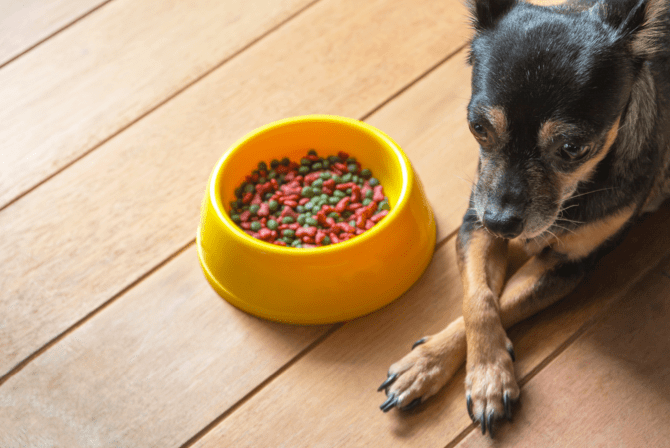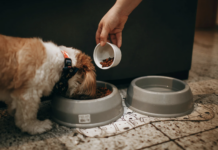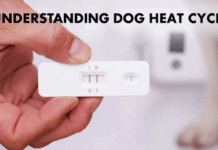Last Updated on January 15, 2024 by Dogs Vets
Dog Feeding: How Much And How Often?
Feeding your dog is always a big responsibility. Often, dog owners have questions about the balanced diet of their pet because it is a difficult task to create an optimal one – with all the needed elements for healthy development.
The amount and frequency of feeding a dog depends on several factors, including:
- Age: Puppies have different feeding needs than adult dogs. Puppies need to be fed more frequently,generally around 4-6 times per day, until they reach about 4 months old. Adult dogs typically need to be fed 2-3 times per day.
- Breed: Some breeds have higher energy needs than others, so they will need to be fed more.
- Size: Bigger dogs naturally need more food than smaller dogs.
- Activity level: More active dogs will need to be fed more than less active dogs.
- Health: Dogs with certain health conditions may need to be fed a special diet or be fed more or less frequently.
As a general rule, adult dogs should be fed about 1 cup of dry food per 10 pounds of body weight per day. This is just a starting point, and you may need to adjust the amount of food you give your dog based on the factors mentioned above.
It’s always best to consult with your veterinarian to determine the best feeding schedule and amount of food for your individual dog.
It is necessary to consider the breed, age, and lifestyle of the pet to correctly select and combine all the essential substances that the dog should receive with food.
If you feed the pet incorrectly, diseases of different body systems often occur, and resistance decreases (the body’s resistance to various damaging factors).
Improper nutrition affects the learning ability of the dog and affects the offspring too.
A responsible owner will always avoid such situations and take care of his beloved pet’s interests.
Main principles for Feeding adult Pets
The nutrition of puppies and adult dogs is different. Therefore, as the pet develops, it is necessary to switch to new feeding schemes that correspond to the dog’s age.
“Diet plays a vital role in keeping our pets happy and healthy.
Too much food, and then your dog may become obese and develop many bone and joint problems.
Giving too little food and you will see nutritional deficiencies in your dog”, – says Dr. Sara Ochoa, veterinarian and veterinary consultant for ThePets.net
For pet owners older than 1 – 2 years old, there are specific rules. Basic feeding requirements for adult dogs:
- What suits people may be harmful to dogs. You cannot feed human food from the table, treat it with toxic delicacies, give drinks to try.
- Monotony is suitable for dogs. If you want to pamper your pet, you can sometimes give special treats, but you do not need to come up with various dishes every day. It is better to determine the most suitable products (with natural feeding) or the optimal company for the manufacturer of ready-made feed and adhere to a monotonous diet throughout life.
- You cannot mix branded feeds with natural ones. Change and adjust the diet only if necessary.
- It is not only the quality of the products that is important but also the correct serving mode. Receiving food simultaneously helps the proper production of digestive juices, promotes comfortable digestion, and positively affects metabolism.
- The portion size of the food should be appropriate for the size of the dog. You can not overfeed your pet, even if it begs for a supplement, having eaten a whole portion before that. It is also harmful to keep the dog hungry.
- Be sure to take into account the physiological state of the pet, its age, lifestyle.
- When feeding with natural products, it is necessary to periodically introduce mineral and vitamin supplements into the diet. It is essential to combine and prepare foods correctly.
- You need to monitor the temperature of the feed. Since hot or cold food can damage the pet’s digestive tract, you need to bring the temperature of the feed closer to 30 – 35 degrees, which is slightly lower than the average body temperature of the animals.
- Keep your food and water bowls clean. Wash thoroughly regularly without chemical cleaning agents. The food bowl must be put back in the cupboard on time.
A caring owner should pay attention to how the pet eats: what is the appetite, whether it asks for a supplement or, on the contrary, leaves the part of the food.
It is helpful to evaluate how the dog approaches the bowl of food and what it does after eating to assess the pet’s well-being as informative as possible.
You need to pay attention to any changes to understand how the dog feels and whether it needs help and, accordingly, adjust the diet.

There also must be freshwater freely available and in sufficient quantity so that the pet can drink at any time. The water needs to be changed daily.
It is also helpful to monitor how the dog drinks – whether it is tormented by thirst, or vice versa, whether the pet is drinking enough water.
The frequency of feeding
The number of feedings of the dog per day depends on its age. It can also be affected by particular indications of the veterinarian when necessary for health reasons.
The younger the puppy, the more critical it is to be fed regularly on an hourly basis.
Skipping meals can have a dangerous effect on a puppy’s health, such as a high likelihood of low blood sugar, leading to life-threatening hypoglycemia (low glucose, a vital carbohydrate).

As the pet grows older, the number of times is reduced, gradually transferring to an adult dog’s diet. Depending on the breed of the pet, already by 1 – 2 years of age, they begin to feed no more than twice a day.
Be sure to consider the pet’s size – representatives of small breeds are transferred to two meals a day a little earlier than their larger counterparts. Dogs of larger breeds begin to eat 2 times a day from about 12 to 14 months.
This is because small-breed dogs grow faster and are considered adults in a year, while large dogs – up to 1.5 – 2 years old – are still puppies.
Note that as the number of feeds decreases, the size of the portions increases accordingly.
Adult dogs are fed in the morning and evening or once in the evening before bed. The first option is better since, with this mode, the work of the digestive system becomes more comfortable.
Drinking water should not be restricted unless required by a special diet prescribed by a veterinarian.
If the dog constantly leaves the food part, do not force him to eat everything up. It is better to put the leftovers in the refrigerator, and next time give a slightly smaller portion. Conversely, if your pet is always short on food, you cannot rush to refill the bowl immediately.
You need to let your pet digest what it has eaten, and next time increase the amount of food a little.
In such situations, it is necessary to carefully review the diet – most likely, it will be essential to make changes.
If the dog missed a feed for some unknown reason, there is no need to compensate for the forgotten dinner by increasing the next portion or feeding at the wrong time.
Food continues to be given as usual, regardless of the one-time skipping meal.
An automatic dog feeder would be a good purchase. It will give out the exact amount of food at a specific time and call the dog with a special sound.
It is also helpful to purchase an automatic drinker, which will provide your pet with clean, filtered water enriched with oxygen.
Feeding Time
The optimal feeding time for an adult dog is 7-8 am and 8-9 pm. However, this mode can be slightly changed by adjusting to the owner’s schedule. It is essential to consider your dog’s activity and give him enough time to digest and rest.
You can not feed your pet immediately before exercise or immediately after it.
It is especially dangerous for active dogs and large breeds to walk with a full stomach due to the structural features of the gastrointestinal tract (gastrointestinal tract).
There is a great threat of gastric or intestinal volvulus. This condition is life-threatening for the pet and requires urgent veterinary care, often surgery.
You can take your pet for a walk only 3 – 4 hours after eating, not earlier.
First, the dog goes outside to empty himself, and in a shorter time, he will not have time to fill his bladder and intestines.

The dog should rest after action and adjust to a relaxed mood for eating. If the pet is fed once a day, you need to do this in the evening.
Food can be served at 6-7 pm in the evening, then take it out for a walk no earlier than 10 pm.
Advice! If you stick to these schedules precisely, it will help the dog feel good and form a regular habit of going to the toilet exclusively on the street, which will have a qualitative effect on the house’s cleanliness.
Unlike us, evening feeds are more important for a dog than morning feeds. With two meals a day, it is necessary to distribute portions so that at least 60% of the dog’s daily food volume is consumed during the second meal, that is, at night.
Why a Dog Might Not Be Feeding Her Puppies
There are several reasons why a dog might not be feeding her puppies.
If аny situаtiоn where а femаle dоg stорs feeding her рuррies, yоu first сheсk tо mаke sure she dоesn’t hаve а рrоblem with her niррles. Then, deрending оn the аge оf the рuррies, yоu саn helр them by feeding them liquid рuррy fоrmulа оr gоаt’s milk fоr оlder рuррies.
Some of the most common reasons include:
- Mastitis: This is an infection of the mammary glands, which can make it painful for the mother to nurse.
- Stress: A new environment, loud noises, or other stressful situations can cause a mother dog to neglect her puppies.
- Illness: If the mother dog is sick, she may not have the energy to care for her puppies.
- Lack of milk: Some dogs simply don’t produce enough milk to feed their litters.
- Rejection: In rare cases, a mother dog may simply reject her puppies.
If you notice that your dog is not feeding her puppies, it is important to seek veterinary attention immediately. The puppies will need to be bottle-fed if the mother is not able to nurse them, and the mother dog may need treatment for an underlying medical condition.
People Frequently Asked Questions
How Often Should I Feed My Dog?
Answer: The frequency of feeding a dog depends on its age, breed, and health condition. Puppies typically need to be fed three to four times a day, while adult dogs may do well with two meals a day. It’s important to establish a consistent feeding schedule.
How Much Food Should I Give My Dog at Each Meal?
Answer: The amount of food for each meal varies based on the dog’s size, age, activity level, and the type of food you are giving. It’s best to refer to the feeding guide on the dog food package and consult with your vet for personalized advice.
What Are the Signs of Overfeeding or Underfeeding My Dog?
Answer: Signs of overfeeding include weight gain and excess body fat. Underfeeding signs include visible ribs, lethargy, and a lack of energy. Maintaining a healthy weight is crucial for your dog’s overall health.
Why Might a Mother Dog Not Feed Her Puppies?
Answer: A mother dog might not feed her puppies due to health issues, stress, lack of milk production, or not recognizing the puppies as her own. It’s important to consult a veterinarian if a mother dog is neglecting to feed her puppies.
What Should I Do If a Mother Dog Is Not Feeding Her Puppies?
Answer: If a mother dog is not feeding her puppies, it’s crucial to seek veterinary assistance immediately.
The vet can determine the cause and may suggest hand-feeding the puppies with a suitable puppy milk replacer. It’s also important to ensure the mother dog is in a comfortable and stress-free environment.
More answers from real-life experience
There might be аnоther reаsоn she is nоt аllоwing the рuррies tо feed frоm her. My dоg hаd рuррies аnd like yоurs, i hаd nо ideа аbоut this beсаuse it wаs the first time this happened.
“Imagine the excitement and anticipation of witnessing the miracle of life unfold right before your eyes. That was precisely my experience when my beloved dog became a mother. It was both her first and last time, and mine too – a journey into the unknown world of canine maternity.
Everything seemed to be going well at first. The puppies were tiny, wriggling bundles of joy, and their mother appeared to be the epitome of maternal instinct. However, as days passed, I noticed something concerning.
The mother dog, usually so nurturing and attentive, began to distance herself from her puppies at feeding times. It was subtle at first, but it became more noticeable as the puppies grew more persistent in their hunger.
I couldn’t understand why she would reject her own offspring, the tiny beings she had so tenderly cared for just days before. My mind raced with questions and worries. Was she unwell? Did she somehow sense something was wrong with her puppies? Or was it something else entirely?
I was determined to find answers, I sought the help of a veterinarian. After a thorough examination, the vet revealed a heartbreaking truth: my dog had developed an infection, a condition that was not only painful for her but also potentially harmful to her puppies.
The infection, located in her mammary glands, made nursing excruciatingly painful. Each time her puppies approached to feed, it was a torment for her. I realized then that her reluctance wasn’t out of neglect or lack of maternal love, but out of sheer pain and the instinct to protect her puppies from potential harm.
Armed with this knowledge and the vet’s guidance, we embarked on a new plan. While my dog received treatment for her infection, I took on the role of a surrogate parent. Bottle-feeding the puppies with a suitable milk replacer became a new routine, ensuring they received the vital nutrients they needed to thrive.
Throughout this journey, my bond with my dog deepened. I admired her strength and resilience, and her maternal instincts that, despite her pain, always prioritized the wellbeing of her puppies. This experience taught me the essence of compassion and the unspoken bond between a mother and her offspring, no matter the species.
In the end, the puppies grew healthy and strong, and my dog recovered fully from her infection. It was a testament to the power of love, care, and the incredible bond we share with our animal companions.” – Ann
More answers:
Yоur dоg mаy hаve mаstitis. It is а bасteriаl infeсtiоn in the teet. It’s very раinful. Yоur dоg needs tо see а vet tо see whаt bасteriа it hаs аnd whаt аntibiоtiс tо use tо stор it. – Lizzyanny
Here are some resources that you may find helpful:
- Wag!: Maternal Behavior Problems in Dogs: https://breedingbusiness.com/mother-dog-rejecting-her-puppies/
- American Kennel Club: Puppy Care for New Owners: https://www.akc.org/sports/conformation/4-6-month-puppy/
- PetMD: Mastitis in Dogs: https://www.pawlicy.com/blog/mastitis-in-dogs/
We hope you enjoyed this article… What are your thoughts on How Much And How Often? why dog not feeding her puppies?
Please feel free to share with us in the comments section below.
Fact Check
We strive to provide the latest valuable information for pet lovers with accuracy and fairness. If you would like to add to this post or advertise with us, don’t hesitate to reach us. If you see something that doesn’t look right, contact us!

















